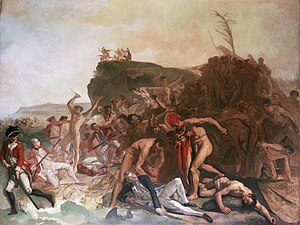ʻAhu ʻula
| The Death of Captain James Cook | |
|---|---|
 |
|
| Artist | Johann Zoffany |
| Year | c. 1795 |
| Type | Oil painting |
| Dimensions | 137.2 cm × 182.9 cm (54.0 in × 72.0 in) |
| Location | National Maritime Museum, London |
Hawaiian feather cloaks, known as ʻAhu ʻula in the Hawaiian language, were worn with feather helmets (mahiole). These were symbols of the highest rank reserved for the men of the aliʻi, the chiefly class of Hawaii. The feathered cloaks and capes were believed to provide spiritual protection of Hawaiian chiefs. There are over 160 examples of this traditional clothing in museums around the world. At least six of these cloaks were collected during the voyages of Captain Cook. These cloaks are made from a woven netting decorated with bird feathers and are examples of fine featherwork techniques. One of these cloaks was included in a painting of Cook's death by Johann Zoffany.
The cloaks were constructed using a woven netting decorated with feathers obtained from local birds. The plant used to make the netting is Touchardia latifolia, a member of the nettle family.
The coloring was achieved using different types of feathers. Black and yellow came from four species of bird called ʻōʻōs. All species had become extinct by 1987, with the probable cause being disease. Black feathers were also sourced from the two species of mamo, which are also now both extinct. The distinctive red feathers came from the ʻIʻiwi and the ʻApapane. Both species can still be found in Hawaii, but in much reduced numbers. Although birds were exploited for their feathers, the effect on the population is thought to be minimal. The birds are said to have not been killed but, rather, caught by specialist bird catchers, a few feathers harvested, and the birds then released.
Hundreds of thousands of feathers were required for each cloak. A small bundle of feathers was gathered and tied into the netting. Bundles were tied in close proximity to form a uniform covering of the surface of the cloak.
...
Wikipedia
